
Citrus is a genus of flowering trees and shrubs in the rue family, Rutaceae. Plants in the genus produce citrus fruits, including important crops such as oranges, lemons, grapefruits, pomelos, and limes. The genus Citrus is native to South Asia, East Asia, Southeast Asia, Melanesia, and Australia. Various citrus species have been used and domesticated by indigenous cultures in these areas since ancient times. From there its cultivation spread into Micronesia and Polynesia by the Austronesian expansion ; and to the Middle East and the Mediterranean via the incense trade route, and onwards to Europe and the Americas.
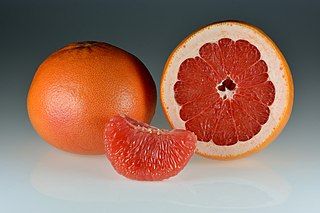
The grapefruit is a subtropical citrus tree known for its relatively large, sour to semi-sweet, somewhat bitter fruit. The interior flesh is segmented and varies in color from pale yellow to dark pink/red.

A clementine is a tangor, a citrus fruit hybrid between a willowleaf mandarin orange and a sweet orange, named in honor of Clément Rodier, a French missionary who first discovered and propagated the cultivar in Algeria. The exterior is a deep orange colour with a smooth, glossy appearance. Clementines can be separated into 7 to 14 segments. Similar to tangerines, they tend to be easy to peel. They are typically juicy and sweet, with less acid than oranges. Their oils, like other citrus fruits, contain mostly limonene as well as myrcene, linalool, α-pinene and many complex aromatics.

The mandarin orange, also known as mandarin or mandarine, is a small, rounded citrus tree fruit. Treated as a distinct species of orange, it is usually eaten plain or in fruit salads. Tangerines are a group of orange-coloured citrus fruit consisting of hybrids of mandarin orange with some pomelo contribution.
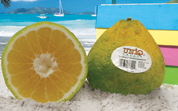
The Jamaican tangelo, also known by proprietary names uglifruit, uglifruit, and uniq fruit, is a citrus fruit that arose on the island of Jamaica through the natural hybridization of a tangerine or orange with a grapefruit, and is thus a tangelo. The original tree is believed to have been a hybrid formed from the Seville orange, the grapefruit and the tangerine families.

The tangelo, Citrus × tangelo, is a citrus fruit hybrid of a Citrus reticulata variety, such as mandarin orange or tangerine, and a Citrus maxima variety, such as a pomelo or grapefruit. The name is a portmanteau of 'tangerine' and 'pomelo'.

The pomelo, from the family Rutaceae, is the largest citrus fruit, and the principal ancestor of the grapefruit. It is a natural, non-hybrid, citrus fruit, native to Southeast Asia. Similar in taste to a sweet grapefruit, the pomelo is commonly consumed and used for festive occasions throughout Southeast Asia. As with the grapefruit, phytochemicals in the pomelo have the potential for drug interactions.

Citrus unshiu is a semi-seedless and easy-peeling citrus species, also known as miyagawa mandarin,unshu mikan, cold hardy mandarin, satsuma mandarin, satsuma orange, naartjie, and tangerine. During the Edo period of Japan, kishu mikan was the most popular because there was a popular superstition that eating Citrus unshiu (Satsuma) without seeds made people more prone to infertility. Citrus unshiu became popular in Japan after modernization started in the Meiji period. It was introduced to the West from the Satsuma region of Japan in 1878.

An oroblanco, oro blanco, pomelit (Israel) or sweetie is a sweet seedless citrus hybrid fruit similar to grapefruit. It is often referred to as oroblanco grapefruit.

Ponkan ; Citrus poonensis; "Chinese Honey Orange") is a high-yield sweet Citrus cultivar with large fruits in the size of an orange. It is a citrus hybrid, though it was once thought to be a pure mandarin.

An orange is a fruit of various citrus species in the family Rutaceae ; it primarily refers to Citrus × sinensis, which is also called sweet orange, to distinguish it from the related Citrus × aurantium, referred to as bitter orange. The sweet orange reproduces asexually ; varieties of the sweet orange arise through mutations.

The ponderosa lemon is a citrus hybrid of a pomelo and a citron. It is not the same as the 'Yuma Ponderosa' lemon-pomelo hybrid used as citrus rootstock.
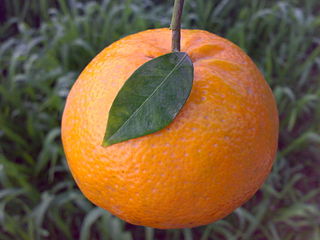
The Kinnow is a high yield mandarin hybrid cultivated extensively in the wider Punjab region of India and Pakistan.

The lemon is a species of small evergreen tree in the flowering plant family Rutaceae, native to Asia, primarily Northeast India (Assam), Northern Myanmar, or China.

The kishu mikan is a hybrid variety of mikan, or mandarin orange, found in Southern China and also grown in Japan. It is more closely related to the mandarin orange than to the common sweet orange.
A mandelo is a citrus fruit that is smaller than a grapefruit, has yellow or yellow-green coloured skin and bright yellow or yellow-orange flesh, but is sweeter than a grapefruit.
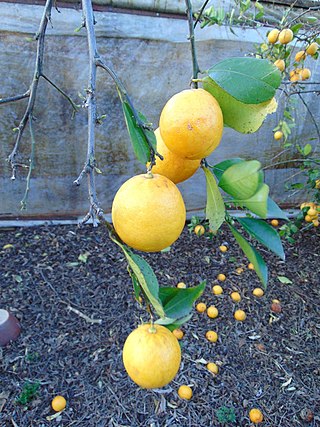
Lemonade fruit, otherwise known as Lemonade lemon, New Zealand lemonade or Unlemon is a variety of sweet lemon citrus fruit, believed to be a hybrid between a mandarin orange and a lemon.

Citrus taxonomy refers to the botanical classification of the species, varieties, cultivars, and graft hybrids within the genus Citrus and related genera, found in cultivation and in the wild.
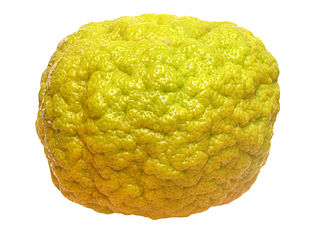
Pompia, also called pumpia, sa pompia, spompia, and China citron, is a Citrus hybrid cultivated for its edible fruit. It is a taxonomical synonym of Citrus medica.


















